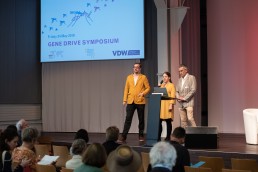
Gene Drive Symposium in Bern - Wiping out unwanted species with CRISPR-Cas?
An interdisciplinary gene drive symposium was held in Bern on May 24, 2019. A report was published highlighting scientific, ecological, social, ethical and regulatory issues related to the gene drive technology.
What is a gene drive?
CRISPR-Cas makes it possible: Gene drives are a genetic engineering process that is used, among other things, with the genetic engineering tool CRISPR-Cas to spread certain traits – such as infertility – quickly and permanently in wild animal and plant populations. The release of such gene-drive organisms is intended to genetically modify or even eradicate entire populations or species in nature. The Gene Drive Symposium in Bern discussed possible applications, social, ethical and ecological consequences as well as regulatory conditions for the use of this technology, which has so far only been tested in the laboratory. The gene drive report published there summarizes the findings.

How does a gene drive work?
CRISPR-Cas is a genetic engineering tool that can search for specific DNA sequences in the genome and break the DNA strands at these points. Genetic engineers make use of the cell’s own repair mechanisms for genetic manipulation: To create a gene drive, the genetic material for CRISPR-Cas is made available to the cell as a repair template. The cell copies this gene sequence into the fracture site and binds the broken DNA. Since the genetic engineering tool itself is thus present in an active form in the genome of the organism, it can become active each time the organism reproduces and copy itself into the genome of the reproductive partner’s gamete. In this way, almost all descendants of a gene drive organism inherit the gene drive and the trait that thus becomes widespread.
Fields of application
The largest field of application for GDO (gene drive organisms) in the future could be agriculture. US researchers and farming associations in particular hope that this technology will be able to decimate insects such as the cherry vinegar fly, aphids and the meal beetle. Overcoming herbicide and pesticide resistance in yield-reducing weeds or insects is also on the wish list of future commercial uses. Gene drives could also be used as biological weapons against plants, animals and humans. For this reason, the US Military Research Institute (DARPA) is one of the largest financiers of gene drive research.
The use of gene drives in malaria-transmitting mosquitoes is the most advanced project and, according to the project team of Target Malaria, will be ready for outdoor testing within five to ten years. Target Malaria, funded by the Bill and Melinda Gates Foundation, aims to eradicate the Anopheles mosquito in Burkina Faso or to genetically modify the mosquito to stop the transmission of malaria.
The nature conservation organisation Island Conservation, on the other hand, hopes to use gene drive organisms to combat invasive rodents that have been introduced into island ecosystems and threaten their biodiversity. For this reason, the idea of using gene drive organisms for nature conservation has been the subject of controversial discussion within the World Conservation Union (IUCN) for several years.
Open ecological, social and ethical questions
Gene drives turns nature into a genetic engineering laboratory. If the gene drive organisms created in the laboratory, for example mosquitoes, flies or mice, are released into nature, they set off a genetic engineering chain reaction that is currently neither spatially nor temporally limited. The result would be a global spread of the new genetically modified organisms. The transformation of the genetic engineering tool CRISPR-Cas, which is prone to mutations and errors, in wild populations is scarcely predictable. Unintended ecological consequences of emerging resistance and mutations, outcrossing into related species or unexpected effects on non-target species would probably be irreversible. Disturbances in the animal food chains and the resulting negative consequences for human food security could not be ruled out. It is questionable whether released gene drive organisms could be retrieved, or whether the ecosystems changed as a result could ever be restored to their original state.
There are also concerns from ethical and social perspectives: Should we presume to override the evolutionary rules of nature so fundamentally? Can such an invasive, totalitarian and disruptive technology, which has been based on patent claims from the beginning, even be adequately controlled? Is such a technology controllable? Which existing alternatives or potential less risky and more democratic solutions will be neglected or not developed at all if billions are currently invested in this high-risk technology?
SOS campaign for a global gene drive moratorium
For Save Our Seeds, gene drives are the most dangerous application of genetic engineering in the environment to date. That is why Save Our Seeds and hundreds of other civil society organizations are calling for a worldwide moratorium on the release of gene drive organisms into the wild. Save Our Seeds wants to spark broad, critical discussion about this technology in society and politics and to win over decision-makers and scientists at national, European and global level to stop the application of this technology before the first specimens are released into the wild. At the same time, SOS promotes respectful treatment of nature that preserves biodiversity and makes it available for human use – instead of exterminating individual species or manipulating them in such a totalitarian way for short-term purposes.
If you would like to support this cause, you can sign the petition for a global gene drive moratorium here.
More detailed information on gene drives from a scientific, ecological, social, ethical and regulatory perspective can be found in the Gene Drive Report published by ENSSER, VDW and CSS at the Gene Drive Symposium in Bern.
At the Gene Drive Symposium on May 24, 2019 in Bern, gene drive developer Kevin Esvelt from MIT in Boston and Ignacio Chapela, Professor of Microbial Ecology at the University of California at Berkeley and Ernst-Ulrich von Weizsäcker discussed possible applications, technical and ecological risks as well as social consequences of the gene drive technology.
Further video recordings of discussions and contributions to the symposium can be found at www.genedrives.ch
